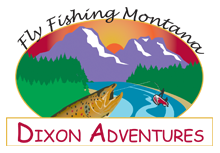August 2013 Fly Fishing Report
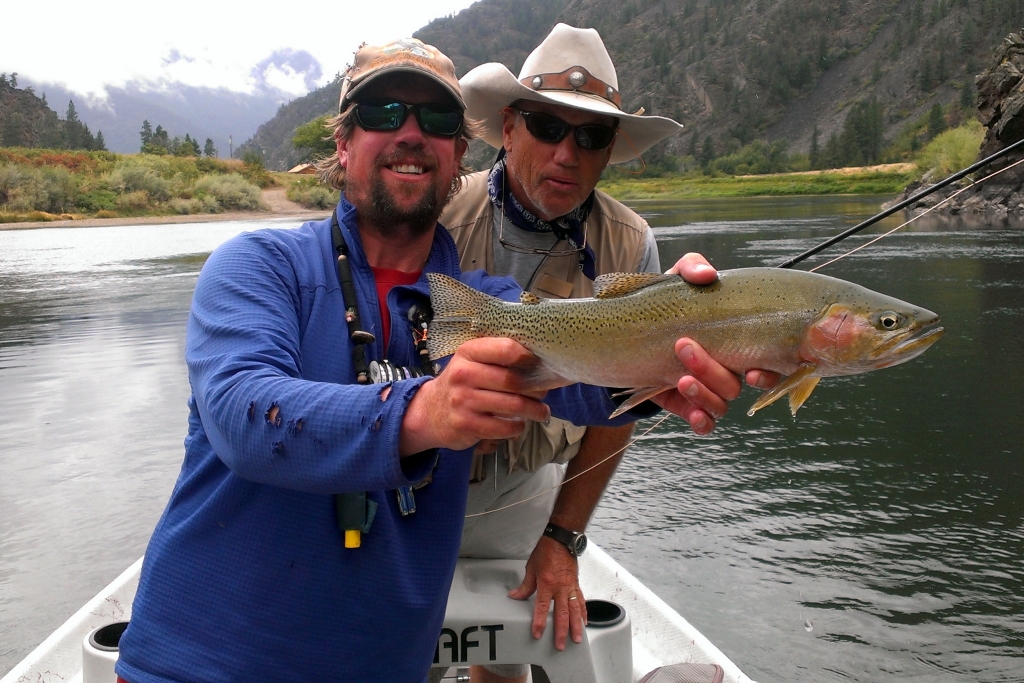
The Clark Fork is fishing pretty well despite the awful heat we had. The timely cool down we had was a savior because the water temperatures were getting pretty warm. Both the upper sections and the lower sections are options. The “hoot owl” restrictions are still in place on the lower river below the confluence of the Blackfoot, but the water temperatures have made it thru the worst part of the season. I would guess that the restrictions will be lifted by the middle of the month. The magic day I have always said is August 15. After August 15 the nights get progressively longer and cooler. This starts our fall hatches like the tricos and hecubas. Tricos love cool nights and warming trends in the morning to really get there spinner dance in full swing. Along with these hatches comes technical fishing. I enjoy the challenge and teaching how to be successful inm this environment, but fair warning, most anglers can get very frustrated targeting trout rising on size 20 spinners. Trout can be in shallow water and feeding on these spinners in a rhythm. When trout are in shallow water they have a larger cone of vision and can see well, which means they can spook easier. There are already tricos on the upper sections, but the trout are not particularly interested in these tiny flies in that water. Trico fishing is interesting. I have always found that there are site specific spots that can be good. Fortunately, the sections close to town has more productive trico fishing than the sections below Alberton Gorge. This hatch is going to be developing and usually in full swing by the end of the month. The hatch can continue thru most of September even, depending on the weather. The dominant tactic at this time of year is fishing hoppers, ants, beetles, moths and other terrestrials. If your fly can handle 4x without twisting it, that is a good choice. Some of the larger hopper patterns may require 3x to prevent your tippet from twisting. Sometimes you have to match your tippet to the fly and not just the trout. The water temperatures down by Superior are creeping up to 70 on the hot days, but should lower more and more as our nights get longer and cooler. The upper sections have some algae, but can produce some fun action in the riffles. I have noticed a much healthier population of 17 inch rainbows in the Clark Fork and hopefully we will have some really large trout in a couple years. The removal of the dam hurt some of our populations of both insects and trout west of town, but I think we are bouncing back strong, just my opinion. Good luck and please be respectful of the trout and the conditions when fishing for them.
July 2013

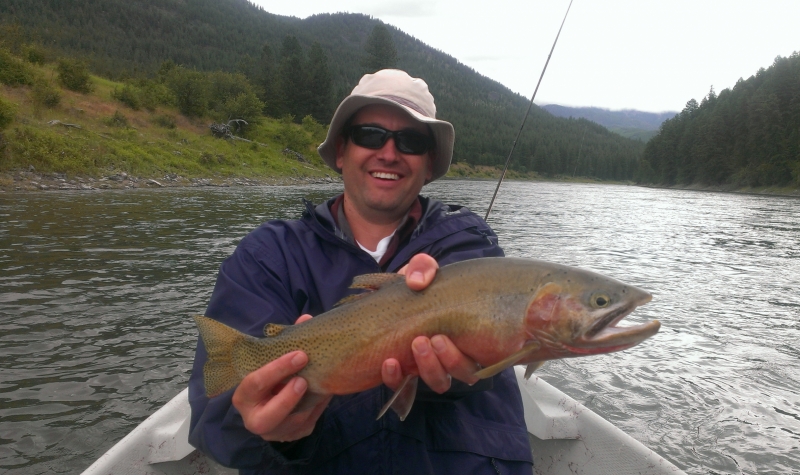
Well, what can I say? The classic line that everyone loves to hear, “You shoulda been here last week.” Dramatic changes thanks to an extreme heat wave like I have never seen this early in the season. And the dramatic changes to the conditions is incredible, and sad I might add. There were reports all over on how the fishing was incredible and that the river was back. Rainbows, fat and healthy in the16-18 inch range. The hatches were incredible with in below average flow and there was cloud cover and rain, a perfect recipe. But that is the past and now we have to assess the current conditions and the near future. Let’s start with the Upper Clark Fork. If you look at the Turah Graph , the CFS is under 1000 and the average is around 1400 CFS. What does this mean? The Upper Clark Fork and stretches through town have had algae blooms and nutrient pollution issues for decades. The bloom started early this season and now that there is lower water, the algae is growing with more productive photosynthesis. The water temperatures got warmed up with the heat wave, but can quickly rebound with cooler nights. Unfortunately, the algae can become a nuisance when it is all broken up. They are like jelly fish floating around ready to grab your fly. But there can be some fun fishing with all the riffles in the upper sections, but you need to be mentally prepared for the nuisance of pulling algae of your fly. You can use dries and dry droppers, but the subsurface game can be ugly with the algae bloom. The lower river was fishing great, but will take some time to recover with better water temperatures. I like to look at the Superior water temperature graph. You can see the result of the heat wave, but the temperatures can become better quickly with cooler temperatures. There stoneflies, mayflies, and a very active caddis super late at night. I will be watching these temperatures closely because they are the key to being successful in the summer, especially on the Lower Clark Fork. There is still some good summer fishing left, the water temps need to recover from the heat and make sure to do your best cold front rain dance!
June 2013
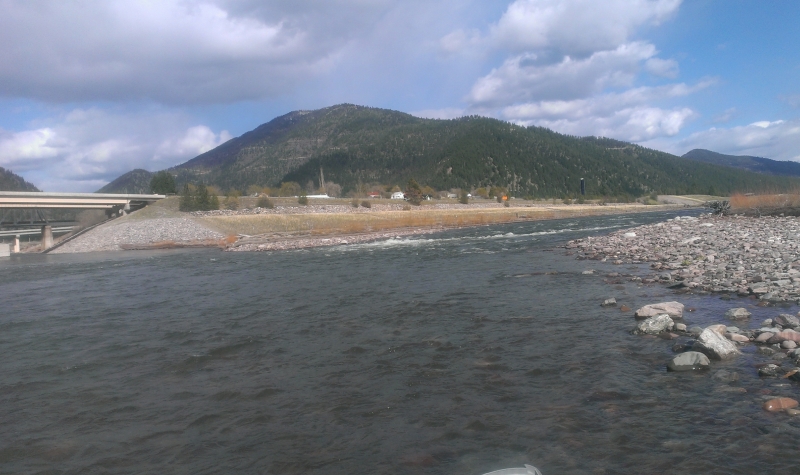

Well, what can I say? The classic line that everyone loves to hear, “You shoulda been here last week.” Dramatic changes thanks to an extreme heat wave like I have never seen this early in the season. And the dramatic changes to the conditions is incredible, and sad I might add. There were reports all over on how the fishing was incredible and that the river was back. Rainbows, fat and healthy in the16-18 inch range. The hatches were incredible with in below average flow and there was cloud cover and rain, a perfect recipe. But that is the past and now we have to assess the current conditions and the near future. Let’s start with the Upper Clark Fork. If you look at the Turah Graph , the CFS is under 1000 and the average is around 1400 CFS. What does this mean? The Upper Clark Fork and stretches through town have had algae blooms and nutrient pollution issues for decades. The bloom started early this season and now that there is lower water, the algae is growing with more productive photosynthesis. The water temperatures got warmed up with the heat wave, but can quickly rebound with cooler nights. Unfortunately, the algae can become a nuisance when it is all broken up. They are like jelly fish floating around ready to grab your fly. But there can be some fun fishing with all the riffles in the upper sections, but you need to be mentally prepared for the nuisance of pulling algae of your fly. You can use dries and dry droppers, but the subsurface game can be ugly with the algae bloom. The lower river was fishing great, but will take some time to recover with better water temperatures. I like to look at the Superior water temperature graph. You can see the result of the heat wave, but the temperatures can become better quickly with cooler temperatures. There stoneflies, mayflies, and a very active caddis super late at night. I will be watching these temperatures closely because they are the key to being successful in the summer, especially on the Lower Clark Fork. There is still some good summer fishing left, the water temps need to recover from the heat and make sure to do your best cold front rain dance!
April 15, 2013

The mighty lower river near St. Regis has dropped almost 3000 CFS and t river is primed up for some good spring fishing. The skwala fishing on the lower river can be phenomenal, but it typically doesn’t get really heat up till late April or even early May. There is some good fishing on the Clark Fork and the cold weather has caused the river to drop and the spring fishing could be very good soon. There have been good reports, even in the recent winter weather, but I think when we warm up later this week into next week, the fishing will get very good. The upper stretches above Missoula are also in great shape and the warmth coming will also produce some great dry fly fishing. The cold snap has stabilized all rivers including the potentially swollen waters of the stretches west of Missoula, and the weather forecast will cause continued stabilized waters and great potential for a variety of hatches. Blue winged olives, March Browns, Skwalas, and Nemouras are all on the trout menu. I expect the fishing on the lower stretches to become very good. Since we had a week of 70 degree temperature that caused the first low elevation run off, it will take some very warm days and especially nights to cause the river to rise again. That means that the triple threat from Missoula is all primed up! Take your pick, Bitterroot, Blackfoot, or Clark Fork (upper or lower)!
March 23, 2013

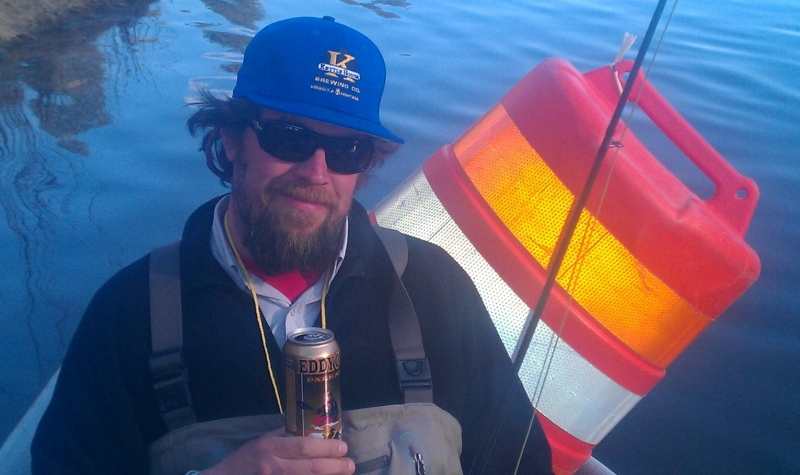
The cold winter weather has slowed the fishing down a little for the Clark Fork, but the spring weather coming should help it heat up a little. This is a photo from last spring, when trying to avoid the Bitterroot crowds. In certain slow water areas, there are some pike that can be targeted. Sometimes these predators can get over 12 lbs in the Clark Fork. The Upper Clark Fork has dangerous snags, so use caution if you are going to try that section. There were some signs of hatches when we had some warm weather last week, but the cold winter returned and the cold waters of Rock Creek and other tributaries have halted the hatches. Fishing on the lower Clark Fork is an option and there may even be some midge sippers in the afternoon, but overall the hatches are always a little later than the Bitterroot at this time of year. Throw your nymphs and streamers and if you want to try and get your first Clark Fork dry fly bite, look for sippers in the scum or scan with a skwala and a dropper. Trout have memory so you can have success pre-hatch because trout know what to start looking for at this time of year. I will leave with one final note. If you are looking for the best beer on the water or after you are fishing, make sure you try our local Kettle House beers. Eddie Out, Double Haul, and Cold Smoke compliment a good day, but especially a slow day on the water well. Here is the Kettle House link. And here is a photo of my best fishing buddy Al Pils with a Kettle House Eddie Out and a construction cone salvaged from the River! Tight Lines!
March 10, 2013

September 15, 2012
Now that the fall fishing has started I am obligated to give you a fishing report. The Clark Fork is not an easy river to give you a report on since it is largest river by volume in the state. The river has Upper, Middle and Lower stretches. I have been fishing on lower stretches to get some relief from the smoke that has been invading the western Montana valleys. The fishing has certainly turned the corner towards fall fishing since we have had some cool and even freezing temperatures at night. This has certainly helped the doldrums of fishing during the dog days of summer by lowering the water temperatures and initiating the fall hatches. As I have stated, the Clark Fork has many miles, so I will try and break it down for you. The upper Clark Fork (above Missoula) is a smaller freestone with heavy riffles. The trout numbers above Rock Creek are low, but there are some interesting developments over the last couple of years since the removal of Miltown Dam. The upper river has been primarily a brown trout fishery, but there is some interesting research that has revealed some exciting results. Here is a brief article from our local newspaper. Missoulian Article. The river just west of Missoula in the middle reaches has more morning trico action to offer than the lower stretches down by Superior. If you want some info on good trico tactics, check out my Bitterroot Fly Fishing Report. I have seen some Hecubas and even blue winged olives and if we could ever get some real fall weather or even rain, the river will have lots of risers. I did enjoy targeting some trout rising the other day and for the most part the dog days of summer have not had many opportunities for casting to rising trout. So things are changing, the trout have felt the cooler weather and the days are getting shorter. With each day that passes, the trout realize that the season to fatten up and prepare for the winter is upon us. The hopper fishing is good at this time of year and as long as the trout are not funked up from a barometer change or heavy winds, the prospecting for trout with attractors can be fun. If I had to guess, besides the sections of the river producing classic trico hatches in the morning, the best time of day to fish is in the early afternoon till about 4 or so. There can be some good fishing after 5 on some of our hot September days, but at this point I can’t wait for some real fall weather that brings rain and makes me put on my waders for the first time. As far as tippet selection, if you are fishing the picky small dries you need 4x and 5x. If you are fishing larger and hoppers you need to have good presentation and match your tippet to your big attractor. There are a lot of flies that will spin your 4x leader and you need to change to 3x so that your leader is not spun and weak when that big trout eats! So all in all the fishing has turned the corner and we have made it through the summer with no closures. The water temperatures are below 60 for most of the river and the trout are happy that the water temperatures are not climbing into the 70s late in the day. Good luck and please do your best rain dance!
August 18, 2012
The fishing always turn the corner after August 15th. The nights start getting longer and the tricos have started to show. This is a good sign because the heat has put us dangerously close to river closures. We had a perfect timely cool down that helped drop the water temps that were pushing over 70 in the afternoons. For the lower Clark Fork I use the Superior Temperature Graph to gauge what the temps are doing. The river is fishing pretty well, but tough in the sun and heat. The fall fishing is coming around the corner and the terrestrial game is the go to tactic right now.
July 27, 2012
The dog days are here and the fishing is getting tough. The first thing I want to say is that we are on the verge of dangerous temperatures on the Lower end of the Clark Fork. We have had some cool nights that help the temperatures, and hopefully we can keep the water temperatures below 70. One of the gauges I look at to judge the temperatures on the lower end is the Superior gauge. This is only a temperature reading station. As I write this report the temperature is reading 21.1 C, which is exactly 70 and no one should be fishing. Please check the temperatures so you can be a responsible fisherman. The weather is getting hotter, but hopefully a cool down and after some cold nights the river can shape up for nice hopper and fall fishing. The Upper Clark Fork is a better option. The water has more oxygen with more riffles and the temperatures of Rock Creek helps keep the water cooler. It is all attractor fishing and the hatches are slim to none. Good luck and know your conditions and water temps.
July 7, 2012

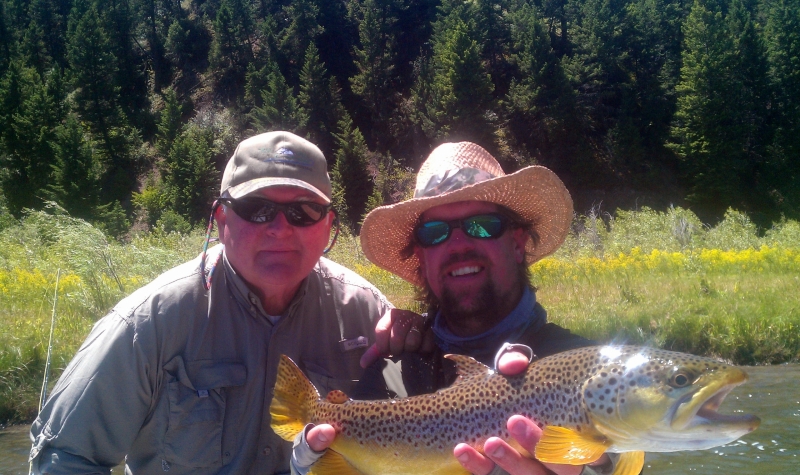
Well I must first apologize to those of you that look at my reports because I was guiding a bunch of long days and I had some problems with my site. So let me see if I can make it up with a good in depth report with both fishing and science information that will help you understand the natural world and how it relates to your fly fishing experiences. Let’s begin by talking about the fishing on the Upper Clark Fork. The Upper Clark Fork flows at Turah are showing a slow decline and I have had some nice days fishing on the Upper Clark Fork this season. The hatches are prolific, but will be on the decline as the heat sets in. Don’t worry, the dog days are not here yet. As a rule I have fished in these sections during the heat because it has lots of oxygenated riffles. Some of the hatches I have seen are multiple stoneflies (sallies, lime or chartreuse stones, big goldens, and more), Drakes, PMDs, Big Yellows (That is just what I call them), sedge caddis in a size 10!, tentwing and antenna caddis, and of course more. The end of June into early July are exciting windows to fish because the trout are on the prowl after run off and they have lots of aquatic options. These hatches will be dwindling all the way until August when we have to fish terrestrials because the aquatic hatches virtually disappear. Of course they return in the fall. There are a couple late summer, elusive, nocturnal stonefly hatches, but the fall mayflies dominate the fall hatches. There is one concern I have this year on the Upper Clark Fork.
I want to try and expand your understanding of algae blooms. There are some algae and grasses that can be healthy for aquatic life, like the Missouri River. However the dark green goopy algae in the Clark Fork is not healthy and can pose a threat to trout and other aquatic life. Missoula has the largest point source nutrient pollution on the Clark Fork Basin with the effluent from the wastewater treatment plant. Fortunately the combination off the clean Bitterroot helps dissipate the nutrients and the algae bloom is not too prolific. However with lots of agricultural influences on the upper sections that hold less water, the bloom can grow large. It is already showing signs to me that the algae might get bad later this summer and I hope we can get some beneficial rain that will help slow down the algae growth. Here is why it can be harmful when it grows too large. The algae uses photosynthesis to survive, just like all plants. And even though it produces some Dissolved Oxygen (DO) during the day, it consumes more than it produces at night and can lower the DO to unhealthy levels. For now there is some algae, but the fishing is good. I thought you might enjoy a little science that can help you understand the trout world. So how do you fish it?
First of all there is a left channel that you need to take a couple miles down from the Clinton put in or you will end up in a portage situation. This section of water had some major reconstructive surgery last year and some channels changed and there are many trees left in the river, so please use caution if you are floating. The woody debris creates great habitat and to fish this section right, you should expect to lose some flies. There are some riffles and runs that are safe from the root balls, but there are a lot of trout that hang out in the logs. I like using larger patterns and even sometimes streamer fishing. You can still get away with 3x in most areas and the trout also are not afraid of a drag full drift (the opposite of drag free, LOL). If the fishing gets tough in the heat don’t be afraid to try some droppers on seams that look like classic holding water. The fishing hours can be tough in that 5 to 9 window, but the late evening caddis can be fun to try and hit. good luck and now let’s talk Lower Clark Fork.
The Clark Fork Flows at St. Regis have plummeted from 14000 to under 10000 in a week! These are some exciting times on the Lower Clark Fork. This weeks heat might make it tough, but since the water temps are 63 degrees in Superior. There is no gauge for level at this site, but I do like monitoring the temps on the lower river here. The fishing can be good in the heat because there are huge stoneflies and an onslaught of mayflies and caddis flies. The early July basics: pmds, drakes, big yellows, and numerous caddis, including a big size 10 sedge. The evening caddis hatch can be fun, but it might be very late and short. Look for eruption rises as the erratic hatching caddis try to escape to the surface. There can be some pods and sippers looking for evening mayflies too. As for the day, the morning hours can have some risers to look for, but I would expect to not see too many rises in the heat of the afternoon until shade hits the water. To fend off the heat, look for heavier riffles and throw some stonefly patterns or even hoppers with droppers. I have always liked using pheasant tails, princes, copper johns, and some homemade specials that have a little purple or red in them. If you want to be unoriginal and use a pattern I never use in the summer, you can always try the san juan worm like some of my fellow guides and outfitters that just can’t stop using those stupid things. They do work, but throwing a caddis pupa or nymph pattern is more fun to try and trick the trout. Worm season is over as far as I am concerned, but you are the boss of your fishing preferences. As long as you are having fun I am just happy to see people fishing! There can be some picky fish that need 4 or even 5x, but with the larger patterns I would recommend 3x, it turns the bug over better and prevents leader twisting. We have some great waters close to Missoula that can have some PHD trout that can be a fun challenge for you. The lower river by Superior and St. Regis has a lot more riffles and can be a nice option for now until the heat drives the water temps up. Hopefully the last of the snow melt can help keep the water temps down as the creeks and tributaries feed cold mountain water into the river. Good luck and wear your sunscreen!
June 11, 2012
The Clark Fork above Missoula near Turah is still big and dangerous for novice rowers, but the fishing can be exciting with the stoneflies around. I have caught trout, and often times large trout, in bad clarity over the years. As long as there are Salmon flies and Golden Stones around, the trout will look to feed on them in very high water conditions. The Lower Clark Fork has a Salmon fly hatch, but the water is big and would be purely experimental. The best results on the Clark Fork will be on the upper stretches, maybe even up near Deerlodge.
June 1, 2012
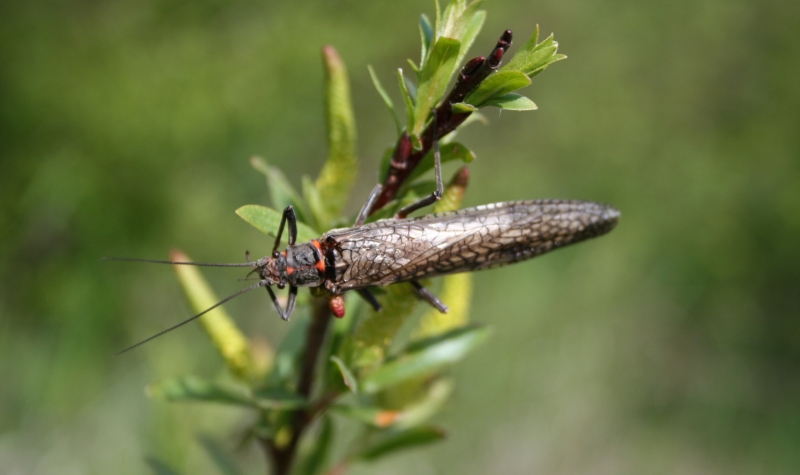
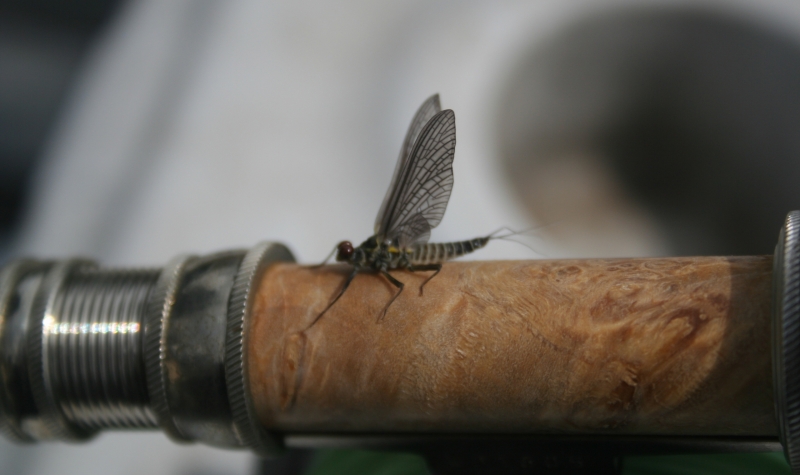
The Clark Fork is on the drop, just like everything else in the state! The best Clark Fork Fishing is on the upper stretches. The Turah Graph shows a slight bump from the weekend weather, but it is flowing clear and rolling at over 2000 cfs. I put the photo of a salmon fly and a green drake, because both of them are hatching. It is very rare, but the Green Drakes usually come out later, but they are loving this weather and they are popping out on the Clark Fork and Rock Creek. There may even be some on the lower river, along with salmon flies, but that is for you to find out! Fishing subsurface is best in the first part of the day and you can bugger/streamer fish or you can nymph some stoneflies and nymphs. Orrrrrrr, you can get a little zany and try the streamer nymph fishing game. That is where you combine your dead drifts with some streamer activity in cliff holes, eddys, and slower areas. You should be using primarily 2x and you can get a little lighter on Drake Patterns, but the tippet size is not crucial since the waters are big and rolling. The only thing crucial about tippet is making sure you are fishing the heaviest line you can fish with because the water oxygen is high, the flows are big, and the trout are strong! Sorry for the break in the report, but now I will be keeping up with the game, so feel free to keep checking them out or call for advice.
April 20, 2012
The photo above was from a couple years ago in the spring in these same flows. I can tell what I will talk about the conditions and the hatches and the spring possibilities. I will not tell you that something is fishing well unless I have a reliable report, and those are hard to come by. I think Fly fishing in Montana on the Clark and most of our Western rivers in the spring is what I call True Fly Fishing.
The Lower Clark Fork at St. Regis has been stable for a week, like all of our other rivers. It is a fun time to fly fish on the Clark Fork. I can tell you this, I have had great fishing in these conditions over the years. The heat coming this weekend might put it on the rise again, but the heat might also create a bug frenzy that can bring some high water trout to the surface. The spring fly fishing on the Lower Clark Fork can be a dicey move that can pay off if you happen to hit it on the right day. The reason the reports are so vague is because nobody knows really, everyone is floating the Bitterroot. So what do you look for? The insect life in all rivers are on the rise. There hatches include Baetis, March Browns, Drakes, Mother’s Day Caddis, and an assortment of stoneflies (skwalas, nemouras, capnias, and others). As I will always state, the worm rig is an option, but I will not put that in every report! That is too basic. The river will be up in the willows and if the stoneflies come out, everything will be looking for them, including the birds. Give it a shot and if it is incredible, then you have discovered an untapped resource for spring fly fishing options. I would fish the triple threat. I usually start with a skwala and a dropper and if the magic happens, maybe the dropper can just come off or be replaced with another dry. If the action is slow or dead, then streamer fish and see if trout are chasing or being aggressive. If no luck still, then maybe use all resorts of nymph tactics, maybe a 6 or 7 foot rig and work the seams and foam holes.
The Upper Clark Fork is probably one of the biggest gambles you can try. You can try up high and the flows at Turah are over 2000 CFS so use caution. The Clinton to Turah stretch went thru major overhaul last year and left trees and jams all over. This stretch is certainly not a beginner rowing stretch. Your only option will be streamers and buggers. There may be some fish in the foam holes on dries if your lucky, but this stretch needs to settle down. The spring fly fishing on the upper stretches can be great. I like using crawler patterns and hand tied zany streamer patterns of different colors.
HATCHES: Baetis, Drakes, Caddis, and Stoneflies
April 1, 2012
The Clark Fork is not an option on the upper or lower stretches. We will keep an eye on it and I will keep you posted. One of the options to fish is the Warm Springs spillway. This can be crowded, butf you can practice your tailwater nymphing with lightning bugs and tiny nymphs. There are some monsters in there so that can be a fun option. As soon as we can get some stable flows after these early pulses of spring run-off, the fishing can be exciting. Keep your fingers crossed.
March 27, 2012
Since the upper Clark Fork has shot up, it is apparent that the warmth has finally started the early, low elevation run off. Rock Creek is running clear still, so sometimes that can mix with the off color upper stretches and create some fishable conditions below Clinton, but right now it is not looking good. The Bitterrot is clear and there may be some visibility in the river on the lower stretches after it comes into the Clark Fork, but for now we have some early run off mud. Things can change fast though, with colder temperatures in the forecast, the Blackfoot and upper reaches of the Clark Fork can stabilize and create some great spring fishing windows. Good luck out there and make sure you do not go fishing in tributaries like Fish Creek because they are illegal to fish until the 3rd saturday in May.
March 21, 2012
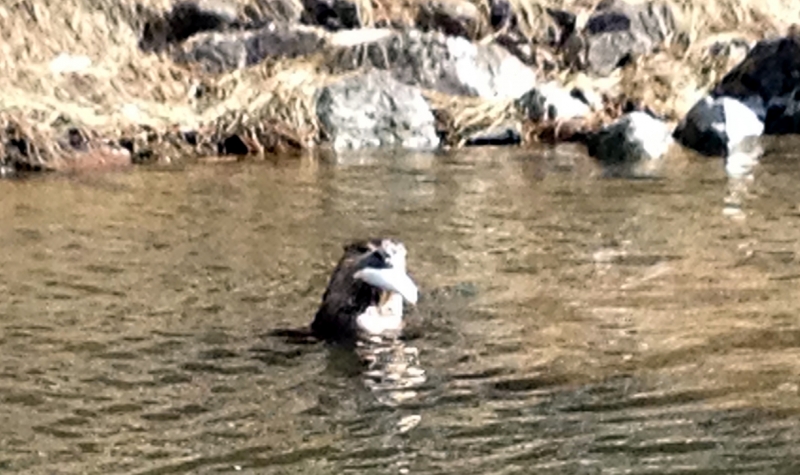

The river otters are out fishing right now, so maybe you should too. The Upper Clark fork has better visibility than the Lower Clark Fork, but after this winter snap, the rivers will stabilize and then rise with spring warmth. Last week there was a pulse of warmth that nearly doubled the Blackfoot and caused the Clark Fork through Missoula and below Missoula to get pretty dirty. So look for similar events to cause sedimentation as the recent and low elevation snow melts. I actually fished in the low visibility last Saturday to avoid Bitterroot crowds and we caught several trout and a pike. It was not good fishing, but it was nice to be out by ourselves. There was only about 2 feet of visibility and we actually found about 4 spots that had trout rising on midges.
TACTICS
The most successful tactic was actually a streamer that we basically tried to swing across. There were a couple hits not long after it hit the water. Then a couple other hits came on the slow retrieve. We tried droppers and missed some, but we did not have any skwala hits. There were a couple pretty cool moments. We came across this river otter that was having too much fun chewing the head off a whitefish! We also found a few spots on the float with some trout feeding on the midges. The midges on the Lower Clark Fork can look the size of baetis in the air, they are pretty big, even a size 18. The feeding areas all had the same features, slow moving water with some foam. Some of the large pools and cliff holes. We had a couple shots at nice fish on midges, but never closed the deal. There will be sparse hatching until this cold snap moves through and we get a little heat. Unfortunately, with that heat, the low elevation melt from the Blackfoot will keep the river dirty. It requires daily investigation in order to determine visibility.
UPPER CLARK FORK
I personally have not fished on the upper yet, but it can be fun to try streamers or double bead stonefly rigs. Be careful in the Clinton-Turah stretch. It changed a lot last year and there are lots of trees to beware of. You can go up to some upper stretches by Deerlodge for an adventure. or anywhere in there. Keep on mind that these stretches will be experience changing flows this spring, so check the graphs and be wary of flood events that will have tributaries rising. As a general rule, the term foam is home might help you. I would not expect too many rising trout, if any, but you never know if you catch a skwala dry bite, I have had some great days over the years on skwalas. Remember the Clark Fork has lots of woody debris and log jams so it is not recommended for the novice rower.
HATCHES
Midges, and maybe some skwalas. Skwalas, baetis, and March Browns will come this spring when the true fun begins!
Check Stream Flows below:
UPPER CLARKFORK
LOWER CLARK FORK BELOW MISSOULA
LOWER CLARK FORK AT ST. REGIS
